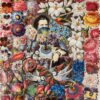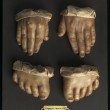Home University of Edinburgh Library Essentials
April 20, 2024
DHC2018 part 2: highlight talks
Posted on September 13, 2018 | in Uncategorized | by Sarah AmesThere were a number of talks which stood out for me, both in terms of general interest and also in their relation to work in libraries. I’ve summarised just a few of these below.
Bob Shoemaker, ‘Lessons from the Digital Panopticon’
This is one of those projects that has it all: vast in scale and scope; multiple collaborators; many different sources of data; reuse of existing digital resources, as well as some new digitisation; and a huge range of research made possible – in many ways, this project was designed to open up more possibilities than it resolves.
Digital Panopticon was funded by the AHRC, with the purpose of assembling all available records about criminals convicted at the Old Bailey between 1785 and 1875, on one platform. This would enable research questions surrounding the effectiveness of different punishments to be asked: the project traces convicts past their punishment and finds out what happened to them.
This involved bringing together 50 datasets, including Old Bailey proceedings, transportation registers, prison registers and census data, 4 million records, and 250,000 individuals – over a 20 year period: the project created ‘life archives’ for each person.
Shoemaker highlighted the benefits of carrying out a study such as this, and on this scale, including the collaborative nature of the work; the ability of the project to reuse and repurpose digital resources; the vast range of research that this resource now enables; and the strong public impact.
However, the limitations of the data also needed to be taken into account: a project like this can marginalise other areas of research, by drawing focus to London, distorting the history of crime, and the digitised material will always be subject to selection bias (a problem that it’s interesting to think about from a library point of view). The project also doesn’t tell the full story of the lives of the convicts – and nor does it claim to – and it’s important to recognise that lives documented are defined solely by their interactions with the state.
From the platform side of things, keeping the site up-to-date after funding has run out continues to be a challenge, as does providing suitable query tools: Shoemaker made the point that we can never fully anticipate the types of analysis that users may wish to conduct, so the ability to download the full dataset has become an important feature. This began an ongoing theme of the conference, concerning the usability of websites and the challenges of making such a resource useful for both researchers and the public.
Jin Gao, ‘What do we write about in the Digital Humanities? A comparative study of Chinese and English publications’
This was a fascinating paper: Gao presented a potted history of digital humanities in China, before comparing the differences between Chinese and English language publications in the field.
There has been no history of digital humanities in China written, and Gao’s paper swept through typesetting, telegraphs, typewriters, technical challenges and digitisation projects, towards a formal establishment of the digital humanities community.
Interestingly from a library point of view, Gao’s analysis of Chinese and English publications found that Chinese papers were more strongly aligned with library topics and tools, while English language articles considered theoretical and technical questions: Library and Information Studies tends to drive digital humanities research in China.
Toby Burrows, ‘Tracing the History of Medieval and Renaissance Manuscripts: the “Mapping Manuscript Migrations” Project’
This project aimed to bring together data from different sources to enable large scale research of manuscripts, particularly relating to provenance and histories of medieval manuscripts. The research questions the project aims to address include: how many manuscripts have survived; where they are now; which people and institutions have been involved in their history.
To do this, researchers from the Universities of Oxford, Pennsylvania and Aalto, and the Institut de Recherche et D’histoire des Textes worked to bring together four datasets, which were a mixture of TEI XML documents and ‘bespoke’ data models. Twelve months in, all data is now in RDF format, and the paper detailed future plans for a web platform and how the results of queries will be presented.
The paper raised a number of issues of interest from a library perspective: what is meant by a ‘manuscript’ and a ‘collection’? How should provenance be documented and encoded using TEI? Should datasets be manually ‘enhanced’ with more data, or could this be pulled in from sources such as Wikidata? And how do we deal with differing data types and formats?
Jo Pugh, ‘How do catalogues make history?’
Pugh discussed the ways in which National Archives catalogue data has been visualised and the research questions that this can address. The paper explored the relationship between the role of archivists and historians, and how digital methods can be used to investigate these further.
By exploring catalogue metadata length; document production data; and citation data, Pugh demonstrated how we can build a broader view of how users interact with archive material, and therefore how archival systems and data (via archives professionals) influences research.
Many more!
And there were many more fascinating talks, which I don’t have space to summarise. Sarah Kenderdine provided an incredible overview of her work, with a particular highlight being the creation of an archive of kung fu master moves; Mia Ridge discussed the great work that the British Library is doing with crowdsourcing to engage users in digitised collections and make them available; and Simon Mahoney and Jin Gao highlighted the biases in digital humanities research, calling for a global view of the field.
As the Library looks to support digital scholarship activity at the University and to engage users with its digital and digitised collections, the insight that the conference has provided into research interests, priorities and challenges has been fascinating, and has highlighted the broader opportunities – as well as challenges – that the field presents to library and IT services.
Collections
 Archival Provenance Project: a glimpse into the university’s history through some of its oldest manuscripts
My name is Madeleine Reynolds, a fourth year PhD candidate in History of Art....
Archival Provenance Project: a glimpse into the university’s history through some of its oldest manuscripts
My name is Madeleine Reynolds, a fourth year PhD candidate in History of Art....
 Rediscovering the Poetry of Louisa Agnes Czarnecki, a 19th-Century Edinburgh Writer and Musician
Today we are publishing a blog by Ash Mowat, a volunteer in the Civic Engagement...
Rediscovering the Poetry of Louisa Agnes Czarnecki, a 19th-Century Edinburgh Writer and Musician
Today we are publishing a blog by Ash Mowat, a volunteer in the Civic Engagement...
Projects
 Giving Decorated Paper a Home … Rehousing Books and Paper Bindings
In the first post of this two part series, our Collection Care Technician, Robyn Rogers,...
Giving Decorated Paper a Home … Rehousing Books and Paper Bindings
In the first post of this two part series, our Collection Care Technician, Robyn Rogers,...
 The Book Surgery Part 2: Bringing Everything Together
In this blog, Project Conservator Mhairi Boyle her second day of in-situ book conservation training...
The Book Surgery Part 2: Bringing Everything Together
In this blog, Project Conservator Mhairi Boyle her second day of in-situ book conservation training...

